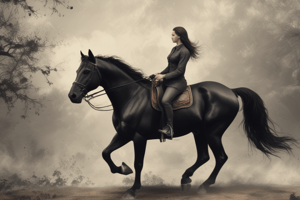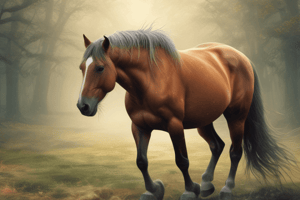Podcast
Questions and Answers
Which level of activity is characterized by strenuous/athletic exercise?
Which level of activity is characterized by strenuous/athletic exercise?
- Intense (correct)
- Moderate
- Heavy
- Light
What is the function of the cecum in horses?
What is the function of the cecum in horses?
- Produce enzymes for protein breakdown
- Absorb vitamins and minerals
- Digest cellulose to VFAs (correct)
- Absorb water
Why is the quality of forages important in a horse's diet?
Why is the quality of forages important in a horse's diet?
- To prevent colic (correct)
- To reduce pregnancy rate
- To induce laminitis
- To regulate body temperature
What is recommended for feeding orphan foals?
What is recommended for feeding orphan foals?
What body condition score is associated with cycling earlier and maintaining pregnancy more easily in broodmares?
What body condition score is associated with cycling earlier and maintaining pregnancy more easily in broodmares?
Which type of feeds should be the main diet component for horses according to the text?
Which type of feeds should be the main diet component for horses according to the text?
What percentage of their body weight can horses consume daily?
What percentage of their body weight can horses consume daily?
Which ratio of Calcium to Phosphorus (Ca:P) is recommended for horse diets?
Which ratio of Calcium to Phosphorus (Ca:P) is recommended for horse diets?
What is the recommended dry matter intake for horses as a percentage of their body weight?
What is the recommended dry matter intake for horses as a percentage of their body weight?
What is the feeding rule regarding cutting balanced rations?
What is the feeding rule regarding cutting balanced rations?
Which method is recommended when switching feed type or quantity for horses?
Which method is recommended when switching feed type or quantity for horses?
What is the primary concern regarding the nutritional needs of the breeding stallion during gestation?
What is the primary concern regarding the nutritional needs of the breeding stallion during gestation?
What should the feeders for foals be like in terms of accessibility?
What should the feeders for foals be like in terms of accessibility?
What are the symptoms associated with pituitary/thyroid troubles in horses during the gestation period?
What are the symptoms associated with pituitary/thyroid troubles in horses during the gestation period?
For geriatric horses, what is the primary concern when selecting feed?
For geriatric horses, what is the primary concern when selecting feed?
Which pasture source do horses prefer according to a Pennsylvania study?
Which pasture source do horses prefer according to a Pennsylvania study?
What does fat supplementation provide to horses according to the text?
What does fat supplementation provide to horses according to the text?
In pasture sources of fat, what is the general behavior of horses compared to cattle?
In pasture sources of fat, what is the general behavior of horses compared to cattle?
What is the recommended height for a good fence attribute in horsekeeping facilities?
What is the recommended height for a good fence attribute in horsekeeping facilities?
When planning fencing, what should be done to prevent flipping over by horses?
When planning fencing, what should be done to prevent flipping over by horses?
What is one of the disadvantages associated with wood fences according to the text?
What is one of the disadvantages associated with wood fences according to the text?
Flashcards are hidden until you start studying
Study Notes
Feeding Weanlings
- Minimize stress and post-weanling slump by feeding 1.5-2.5lbs of grain and 0.7-1.0lb of hay per 100lbs of body weight
- Monitor feed and water intake, and ensure Ca>P ratio
Feeding Yearlings
- For sales and show, feed high-quality concentrate at 0.075lb/100lb body weight
- For growth, feed 1.0-2.0lb/100lb body weight
- Turn out for 1-3 months, and then provide forage and concentrate in a 1:1 ratio
Nutrition for Lactating Mares
- Milk production requires 3% of body weight in energy and 2% in protein
- Increase energy and protein requirements by 90% and 50% respectively
- Provide a minimum of 1.3% protein and 1.2Mcal/lb of digestible energy from forage
- Ensure Ca:P ratio of 2:1
Nutrition for Breeding Stallions
- Primary concern is providing nutrients for fetal growth and development
- Feed 0.5% concentrate and 1.75-2.0% hay of body weight
- Provide vitamin and mineral supplements to prevent decreased kidney and liver function
Geriatric Horses
- Maintenance energy requirements are met with 70% of horses over 20 years old
- Feed 1.75-2.0% of body weight in forage and 0.5-0.75% in concentrate
- Provide vitamin and mineral supplements to prevent pituitary and thyroid tumors
- Ensure 11% CP, 1.0Mcal/lb of digestible energy, and 0.45% Ca and 0.34% P
Fat Supplementation
- Provide highly palatable and easy-to-chew fat sources
- Increase energy from fat, which is 90% utilizable
- Ensure fat sources are clean and dust-free
Horse and Pasture
- A grass-legume pasture can meet the maintenance requirements of most adult horses
- Horses prefer grasses over legumes and tend to be destructive to pasture
Selection of Feed for Geriatric Horses
- Choose feeds with high digestible energy, protein, and fiber
- Increase iron, vitamins A, D, and E
- Ensure fat sources are highly digestible and aid in digestion
Horsekeeping Facilities
- Design facilities to prevent dominant horses from trapping subordinates
- Use round-off corners and tilt tensioned wire fences to resist inward forces
- Ensure fences are highly visible, withstand impacts, and have no openings that can trap head or foot
Planning Fencing
- Allow easy access to pastures and do not limit performance of stable chores
- Ensure gates are easy to open with one hand and allow easy movement of groups of horses
- Use double fencing for stallions and valuable stock to eliminate social and antisocial activity
Life-Stage Feeding
- Feed according to life stage, level of activity, and individual digestive and metabolic efficiency
- Ensure dry matter intake is 1.5-2.0% of body weight, and most horses meet energy requirements with forage alone
Studying That Suits You
Use AI to generate personalized quizzes and flashcards to suit your learning preferences.




